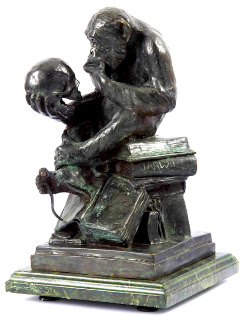Simian Shakespeare
Yesterday I swung over to the 40th annual meeting of the Shakespeare Association of America to be a respondent in a session on the The "Famous Ape": Shakespeare and Primatology organized by Holly Dugan and chaired by Linda Woodbridge featuring some truly excellent and engaging talks by Ken, Holly, and Scott (titles below).
“The Simian / Human Boundary in Renaissance Culture”
Kenneth Gouwens (UConn)
“The Monkey of Venice”
Holly Dugan (GWU)
“Return to the Poet of the Apes”
Scott Maisano (UMass Boston)
It turns out that primates are frequently featured in the plays and poems of William Shakespeare, indeed apes and monkeys are mentioned in 2/3rds of his plays. How did I not know this?!?
Oh right, I am the wrong kind of nerd.
Luckily for us primatologists, Scott and Holly are writing a book on Shakespeare's primates! Ken is working on a book too, about the role of primates in Europe during the Renaissance. So cool!
I was delighted to participate because I got to dust off my Shakespeare knowledge gained from the unparalleled Nada Oakley at Seattle Central Community College in 1996. On top of that I had a great time interacting with humanities scholars and found it incredibly refreshing that they really understood the state of primate cognition science (which also reflects how well comparative cognitive scientists are at communicating beyond their discipline, so kudos to them too!) At moments I felt a bit like a Barbarian among Greeks, but frankly, I’ve been feeling like that not infrequently of late. Here is my respondent piece:
Oh right, I am the wrong kind of nerd.
Luckily for us primatologists, Scott and Holly are writing a book on Shakespeare's primates! Ken is working on a book too, about the role of primates in Europe during the Renaissance. So cool!
I was delighted to participate because I got to dust off my Shakespeare knowledge gained from the unparalleled Nada Oakley at Seattle Central Community College in 1996. On top of that I had a great time interacting with humanities scholars and found it incredibly refreshing that they really understood the state of primate cognition science (which also reflects how well comparative cognitive scientists are at communicating beyond their discipline, so kudos to them too!) At moments I felt a bit like a Barbarian among Greeks, but frankly, I’ve been feeling like that not infrequently of late. Here is my respondent piece:
Shakespeare’s use of primate devices to confront “animal” aspects of human nature are as salient today as in the Elizabethan Age because uniquely among beasts, in these creatures do we see ourselves. If we were shuffled loose our moral coil, would we be as apes and monkeys?
Jan Brueghel the Younger, Satire on Tulip Mania, c. 1640
However it is in the “mind’s eye” of the poet, the artist, and the writer that the chasm between human and ape is most effortlessly spanned. This poets’ perspective stands in stark contrast with most of the history of primatology as a distinct academic discipline. The father of modern anthropology, Franz Boas, integrated the study of primates to inform our evolutionary understanding of humans. However despite this intellectual mandate, the attribution of emotions, intentions, and memory to animals was considered the antithesis of objective Science. Humans are not animals and animals are not humans.
But as the 20th century unfolded, one by one, pillars of human uniqueness disintegrated. Tool use, hunting, warfare, culture, and theory of mind- each of these were adamantly defended as a defining characteristic of humans. Until chimpanzees, gorillas, baboons, macaques, and capuchin monkeys exceeded thresholds of “humankind.”
Teleological thinking, reminiscent of the Great Chain of Being, persists to this day, even among individuals who accept that adaptations are the product of natural selection and that evolutionary processes generate and eliminate species. However apes and monkeys are not static creatures existing in nature’s museum suspended in time and condition from which we alone have emerged "evolved." Their minds are adapted to solve their problems, just as our minds solve ours. In this way “nature must obey necessity.” Humans are animals, and animals are our contemporaries.
I will revisit those themes outlined so wonderfully by Holly, Scott, and Ken- with the true story of Freud and Frodo, Chimpanzees of Gombe National Park in Tanzania. (special thanks to Zarin Machanda for suggesting this “Et tu, Brute?” story!)
Freud and Frodo were brothers (Freud was the elder) born to the highest-ranking female at Gombe. As juveniles, the brothers socially benefited from both their high ranking mother and their uncle, Figan, who was the alpha male. In 1993, Freud became the alpha male with the support of his more aggressive, younger brother Frodo, who simultaneously became the second highest ranked male in the community. The brothers enjoyed the most matings, with the most desirable females. They could take hunted meat from lower-ranking males. They could demand to be groomed. This dynamic lasted for 4 years until Freud became ill. When Freud’s hold on alpha status became vulnerable, his brother Frodo did not come to his aid. Instead Frodo would join as an ally with other males that challenged Freud. As Freud dropped to the middle of the hierarchy, Frodo emerged as alpha and held onto the position for 5 years.
(Credit: iStockphoto/Gary Wales)
Frodo was characterized as a particularly aggressive and despotic alpha male. He regularly terrorized the other individuals in his community. He was eventually deposed by a coalition of 4 males. He was severely injured and became ill and for many months lived in the hinterlands away from the group. Amazingly, Frodo was able to recover and returned to the group, catapulting back to high rank, and almost vindictively more aggressive to the males that have previously deposed him.
The drama of daily life among chimpanzees is unquestionably Shakespearean- deceit, insight, aggression, and betrayal. This is the consequence of being a socially complex animal. And as a closely related, exceedingly social animal ourselves, their struggles resonate in reflections of our own lives. We experience the same anguish and the same delight for the same reasons they do.
However, there remain truly unique features of humans- language, art, and cooperation at an unparalleled scale. And this suite of human characteristics is quite evident in our uniting together today to discuss the literary art of William Shakespeare.
As an added bonus on my Shakespeare day, last night I attended an undergraduate production of Twelfth Night (a student in my Neurobiology of Sociality seminar plays Malvolio). It was fantastic! Details for the performance schedule can be found here.
PS: Thanks for suggesting me as a respondent Richard!





Comments
Post a Comment